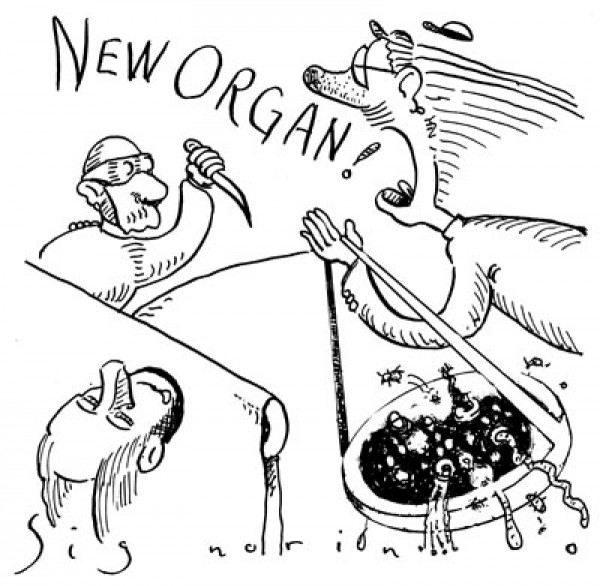
If a cancerous tumor were cut out of someone, and said tumor was placed in someone else’s body for some reason, would the transplanted tumor thrive? —Pink Teet
Yes. We know this because cancer is transplanted by accident all the time.
Organ and tissue transplants have saved countless lives. But they pose risks, one of which is transplanting a disease from the donor to the host. In the case of cancer, there are two primary scenarios for transmission: cancer that forms in the transplanted cells, and cancer cells that are directly transplanted.
There are loads of case reports telling us this happens, but how frequently is hard to say. Although studies for the most part suggest the risk is low, results have been all over the place:
• Looking at 30 years of transplants, the Israel Penn International Transplant Tumor Registry found when a donor had cancer, it was transplanted to the recipient an astonishing 43 percent of the time. Kidney, uterine, and skin cancer were the most commonly transplanted types.
• In contrast, a study by the United Network of Organ Sharing found zero cancers transmitted via 1,276 organs transplanted from donors with cancer. However, a review showed most of the cancers in question were either low-grade or non-melanoma skin cancers.
• Another UNOS study of 108,000 U.S. transplants from 1994 to 2001 found just 21 transplanted cancers.
n A study of organ transplants from deceased donors in the United States from 2005 to 2007 found cancer and disease transmission in general occurred less than 1 percent of the time. Other studies have put the risk of cancer transmission at about two in 10,000 transplants.
When a recipient does develop cancer from a transplant, the prognosis is generally grim. Usually these are already weakened people placed on immunosuppressant drugs to prevent organ rejection. Treating transplanted cancerous organs typically involves stopping the immunosuppressant drugs and removing the organ, subjecting the patient to another major surgery, and a return to their prior bad situation.
A study of 104 cases of cancer transplanted to kidney recipients from 1948 to 2012 found 72 percent of those given melanomas were dead within 30 months of transplantation, and two-thirds of lung cancer recipients were gone within 20 months. Twenty patients had actual kidney cancers transplanted into them, and three died. A study of 2009 data found 14 percent of the time when the donor had cancer it was transmitted, and death resulted in half of those transmission cases. When the donor was infected with a communicable disease, fungus, or parasite, 53 per cent of the time it was passed on to the recipient—and more than a quarter of those recipients died as a result.
Cancer isn’t the only thing that can be transplanted. Herpes viruses can easily be transmitted from donor to recipient—Kaposi’s sarcoma due to transmitted herpes occurs in as many as 5 percent of kidney recipients.
HIV can be both hidden and virulent. In one instance doctors transplanted four organs and numerous bits of tissue from a 22-year-old gunshot victim with no known HIV risk factors into more than 50 recipients. Then they discovered he was HIV-positive. At least seven people, including all four organ recipients, contracted the virus.
Rabies has been transmitted via cornea transplant, the most common type of transplant and normally a pretty safe one. In one case, a person who died of undetected rabies donated two corneas, killing both recipients within 50 days. In another case, rabies was transmitted from an infected donor to the four recipients of his liver, kidneys and an artery, quickly killing them all. Toxoplasmosis and cytomegalovirus—infections that are generally no big deal for people with healthy immune systems, but scary for transplant recipients—have been transmitted via heart transplant. Kidney transplants appear to be especially problematic, with several different types of fungi, parasites and bacterial infections reportedly transferable from donor to recipient.
Notwithstanding the risks, even when doctors know a prospective donor has cancer, they don’t necessarily rule out donation. The waiting list for organ transplants is so long—currently 77,000 Americans—that under the right circumstances the risk is sometimes deemed worth taking. If the cancer in the transplanted organ can be isolated and cleanly removed, for example, the medical team may advise a recipient it’s worth a shot. One study of 43 kidney transplants involving tumors less than three centimeters in diameter found only one recurrence of cancer in nine years.
There’s no guarantee, though. Again, corneal transplants are thought to be fairly safe, but at least one case of cancer was transmitted that way.
Once in a while a transplanted-cancer story has a happy ending. In a case reported in 2006, a kidney donated by a father to his daughter turned out to contain previously unsuspected cancer. Surgeons were able to remove the diseased part of the donated kidney and keep the rest going. Upshot: the father had a potentially fatal cancer removed, the daughter got a lifesaving transplant, and a year later both were alive and cancer free. Never mind winning the lottery—you don’t get much luckier than that.
Send questions to Cecil via straightdope.com or write him c/o Chicago Reader, 350 N. Orleans, Chicago 60654.